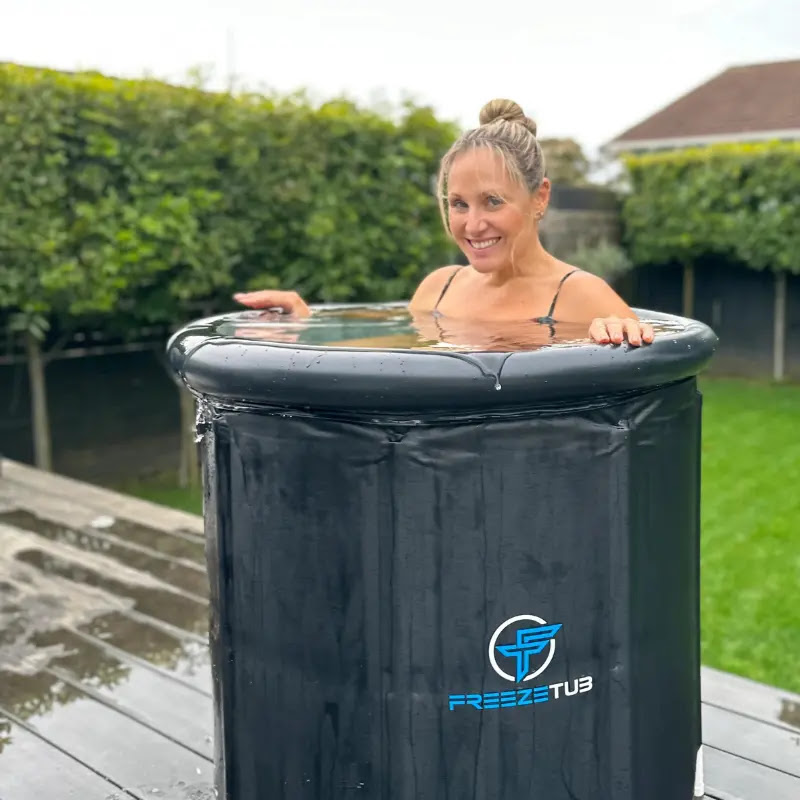An ice bath is a form of cryotherapy (cold therapy). It involves soaking the legs, hips, and lower back in a tub of very cold water or ice water after a workout to reduce inflammation and soreness.

There have been conflicting results from studies investigating the efficacy of ice baths on muscle recovery. Some studies have shown significant decreases in muscle soreness and inflammatory markers, while others have not. Similarly, some studies have shown performance benefits whereas others have not.
Other studies have concluded that ice baths may be an effective recovery modality, but no more so than active recovery options like light jogging.
Sore after a race, long run, or hard workout? The primary purpose of ice baths is to reduce muscle soreness and many studies have indeed demonstrated that ice baths can reduce soreness after exercise.
The cold exposure causes the blood vessels in your submerged legs and hips to constrict. When you get out of the ice bath, these blood vessels dilate rapidly, flushing out the metabolic waste products that can cause delayed-onset muscle soreness (DOMS) and increase nutritive blood flow.
The cryotherapy and hydrostatic pressure of water against your legs in an ice bath can reduce inflammation after a run.
The decrease in DOMS and other recovery-promoting benefits of ice baths can reduce fatigue after your run so that you bounce back faster for the next workout.
As many runners feel like ice baths facilitate recovery from workouts, regularly doing ice baths can potentially allow you to train harder more often, which can lead to greater increases in performance.
There is some evidence to suggest that cold water immersion therapy may improve sleep. However, it’s important to note that results were most favorable when the entire body was submerged, including the athlete’s head.
This benefit is thought to be largely due to the effect of the ice bath on the central nervous system.
Perhaps the most uncontested of the ice bath benefits is the mental toughness you can develop by forcing yourself to get in and endure the wildly uncomfortable soak.
Running takes grit, determination, and perseverance, and many elite athletes say that training yourself to endure an ice bath translates to your toughness as an athlete.
When you dip your toe into an ice bath, everything in your head screams, “I can’t get in that!” However, if you work up the nerve and get in, the initial intense discomfort quickly wanes as you become numb.
Much like staring down a difficult and daunting workout or race, you find that your mind can try to talk you out of things you can absolutely do.
Water freezes at 0 degrees C and 32 degrees F. Most rehabilitation specialists say an ice bath should be about 10-15 degrees C or 50-60 degrees F.
The answer to how long should an ice bath be is what generally pulls us away from the idea. The general consensus from the literature is that the ideal length of an ice bath is 11-15 minutes. This maximizes the cryotherapy benefits of cold water immersion without inducing excessive stress or putting tissues at risk of frostbite or the body at risk of hypothermia.
If you are new to ice baths, start with 5 minutes and gradually work your way up to a maximum of 15 minutes.
After an ice bath, carefully get out, towel off completely, and put on warm, dry clothes. Note that your feet may be numb, so you should move around carefully and deliberately so that you don’t fall.
If you are really cold, you might consider taking a warm shower and drinking hot beverages. Be careful with the temperature of your shower water as your skin may not be able to properly detect how hot the water is.
Ice BathsExtended cold exposure can lead to frostbite or hypothermia. Do NOT stay in the ice bath longer than 15 minutes. If you suffer from circulation issues or have peripheral neuropathy, do NOT take an ice bath without consulting your healthcare provider first.
If you are pregnant, have diabetes, cardiovascular disease, hypertension, low blood pressure, or POTS, ice baths may not be safe. Consult your healthcare provider prior to trying an ice bath after a run.
Unless you have access to an athletic training room, chances are you’ll have to fashion an ice bath at home. You’ll need a bathtub or a very large container like a child-sized swimming pool.
Unless you only want to soak your lower legs, fill the tub as high as possible, leaving room to accommodate the water your body will displace when you get it.
Wait about 10 minutes to allow the water to chill. If you have a thermometer, you’re striving for 10-15 degrees C or 50-60 degrees F.
Getting in and staying in an ice bath isn’t easy. Here are a few tips to make them more tolerable, so you can reap the ice bath benefits:
Tentatively dipping a toe in can make the process overwhelmingly unappealing. Take a deep breath, and try to get in all at once.
Your feet are often the most uncomfortable, but neoprene wetsuit socks or booties can provide the protection you need.
If your torso can’t fit in the tub under the water anyway, wear a sweatshirt or top to keep your upper body warm.
If you are really struggling to get in your ice bath, just start with cold water. After you get in, pour in the ice. You’ll want to stay in the ice bath a little longer (up to 20 minutes) since the water won’t be as cold to start, but it’s a more approachable way to acclimate to the ice bath.
Now that we’ve discussed the potential ice bath benefits, and tips to take one, why not give it a try to see if it can help you improve your recovery? You can also take a look at some of our other helpful recovery tips in our article: Sore Legs After Running? Try These Recovery Techniques.
Embarking on the journey of ice baths can be both exciting and daunting for beginners. Setting the ideal temperature for your ice bath is crucial to maximize the therapeutic benefits and ensure a safe and enjoyable experience.
In this comprehensive guide, we will explore everything you need to know about determining the ideal temperature for ice baths. From the science behind temperature effects on the body to practical tips and considerations, we’ve got you covered.
Ice baths, also known as cold water immersion therapy, leverage the effects of cold temperature on the body to trigger physiological responses.
When exposed to cold water, blood vessels constrict, reducing blood flow to muscles and tissues. This constriction can help reduce inflammation, numb pain receptors, and promote muscle recovery. The ideal temperature range for ice baths typically falls between 50 to 60 degrees Fahrenheit (10 to 15 degrees Celsius).
While the suggested temperature range serves as a starting point, individual preferences and tolerances may vary. Some individuals may find slightly lower or higher temperatures more comfortable or effective for their specific needs.
.jpg)

.jpg)

